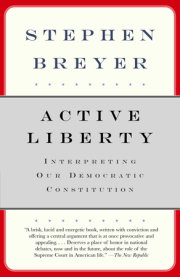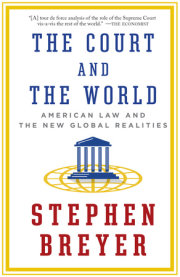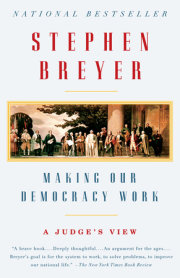THE THEME: ACTIVE LIBERTY THE THEME CONSIDERED . . . The concept of active liberty--as I said at the outset--refers to a sharing of a nation's sovereign authority among its people. Sovereignty involves the legitimacy of a governmental action. And a sharing of sovereign authority suggests several kinds of connection between that legitimacy and the people.For one thing, it should be possible to trace without much difficulty a line of authority for the making of governmental decisions back to the people themselves--either directly, or indirectly through those whom the people have chosen, perhaps instructed, to make certain kinds of decisions in certain ways. And this authority must be broad. The people must have room to decide and leeway to make mistakes.For another, the people themselves should participate in government--though their participation may vary in degree. Participation is most forceful when it is direct, involving, for example, voting, town meetings, political party membership, or issue- or interest-related activities. It is weak, but still minimally exists, to the extent that it is vicarious, reflected, say, in the understanding that each individual belongs to the political community with the right to participate should he or she choose to do so.Finally, the people, and their representatives, must have the capacity to exercise their democratic responsibilities. They should possess the tools, such as information and education, necessary to participate and to govern effectively.When I speak of active liberty, I mean to suggest connections of this kind between the people and their government--connections that involve responsibility, participation, and capacity. Moreover, active liberty cannot be understood in a vacuum, for it operates in the real world. And in the real world, institutions and methods of interpretation must be designed in a way such that this form of liberty is both sustainable over time and capable of translating the people's will into sound policies.
. . . AS FALLING WITHIN AN INTERPRETIVE TRADITION . . . The theme as I here consider it falls within an interpretive tradition. That tradition encompasses a particular view of democracy, as including not only the "rights of the whole people," but also "the duties of the whole people." And it calls for judicial restraint, basing that call upon both technical circumstance and democratic value. As to the first, "[c]ourts are ill-equipped to make the investigations which should precede" most legislation. As to the second, a judge's "agreement or disagreement" about the wisdom of a law "has nothing to do with the right of a majority to embody their opinions in law." For both kinds of reasons, even if a judge knows "what the just result should be," that judge "is not to substitute even his juster will" for that of "the people." In a constitutional democracy "a deep-seated conviction on the part of the people . . . is entitled to great respect."1That tradition sees texts as driven by purposes. The judge should try to find and "honestly . . . say what was the underlying purpose expressed" in a statute. The judge should read constitutional language "as the revelation of the great purposes which were intended to be achieved by the Constitution" itself, a "framework for" and a "continuing instrument of government." The judge should recognize that the Constitution will apply to "new subject matter . . . with which the framers were not familiar." Thus, the judge, whether applying statute or Constitution, should "reconstruct the past solution imaginatively in its setting and project the purposes which inspired it upon the concrete occasions which arise for their decision." Since law is connected to life, judges, in applying a text in light of its purpose, should look to consequences, including "contemporary conditions, social, industrial, and political, of the community to be affected." And since "the purpose of construction is the ascertainment of meaning, nothing that is logically relevant should be excluded."2That tradition does not expect highly general instructions themselves to determine the outcome of difficult concrete cases where language is open-ended and precisely defined purpose is difficult to ascertain. Certain constitutional language, for example, reflects "fundamental aspirations and . . . 'moods,' embodied in provisions like the due process and equal protection clauses, which were designed not to be precise and positive directions for rules of action." A judge, when interpreting such open-ended provisions, must avoid being "willful, in the sense of enforcing individual views." A judge cannot "enforce whatever he thinks best." "In the exercise of" the "high power" of judicial review, says Justice Louis Brandeis, "we must be ever on our guard, lest we erect our prejudices into legal principles." At the same time, a judge must avoid being "wooden, in uncritically resting on formulas, in assuming the familiar to be the necessary, in not realizing that any problem can be solved if only one principle is involved but that unfortunately all controversies of importance involve if not a conflict at least an interplay of principles."3How, then, is the judge to act between the bounds of the "willful" and the "wooden"? The tradition answers with an attitude, an attitude that hesitates to rely upon any single theory or grand view of law, of interpretation, or of the Constitution. It champions the need to search for purposes; it calls for restraint, asking judges to "speak . . . humbly as the voice of the law." And it finds in the democratic nature of our system more than simply a justification for judicial restraint. Holmes reminds the judge as a general matter to allow "[c]onsiderable latitude . . . for differences of view." And Learned Hand describes both legislative and judicial democratic attitudes when he says that the "spirit which seeks to understand the minds of other men and women," the "spirit which weighs their interests alongside its own without bias," is the "spirit of liberty" itself.4My discussion of active liberty falls within the broad outlines of the tradition these statements suggest. But it takes place in a different time. The statements I have quoted, from Holmes, Brandeis, Stone, Frankfurter, and Hand, must be read in light of later decisions that abolished legal segregation, that gave life to the Constitution's liberty-protecting promises, that helped to make "We the People" a phrase that finally includes those whom the Constitution originally and intentionally ignored. The discussion welcomes those decisions as furthering the Constitution's basic objectives. One of my objectives is to illustrate why one can, without philosophical contradiction, essentially embrace the later decisions without essentially abandoning the traditional attitude. That is to say, the philosophical tension is sometimes less than some have imagined.5
. . . CONSISTENT WITH THE CONSTITUTION'S HISTORY Is it reasonable from a historical perspective to view the Constitution as centrally focused upon active liberty, upon the right of individuals to participate in democratic self-government? I believe so. I have already listed various constitutional provisions that specifically further that objective. And the now standard historical accounts of the writing of the Constitution--in the works, for example, of Gordon Wood and Bernard Bailyn--make clear that active liberty, the principle of participatory self-government, was a primary force shaping the system of government that the document creates.1The primarily democratic nature of the Constitution's governmental structure has not always seemed obvious. John Adams, for example, understood the Constitution as seeking to create an Aristotelian "mixed" form of government. Our government, like the British government, would reflect the structure of eighteenth-century society. The House of Representatives, like the House of Commons, would constitute the "democratical branch" of the new federal government, embodying the people's basic decency and common sense. The Senate, like the House of Lords, would represent the aristocratic element of society, embodying its wisdom while checking the people's sometimes "barbarous . . . and cruel" passions. The Executive would represent the monarchical element of society, with the President serving as a mediator, a balancer, helping to keep social forces in equilibrium.2But Adams himself recognized that his notions of constitutionalism were not widely shared. And historians now tell us that by the time the Constitution was ratified by the states, the more "aristocratic" concept held by some of the Framers was a minority view. Rather, the document created a governmental structure that reflected the view that sovereign authority originated in the people; that the "Right to legislate is originally in every Member of the Community." An important imperative modified but also reinforced this right, namely the need to protect individual liberty (i.e., the liberty of the moderns). The right was also subject to an important constraint, namely the need for workable government. The term "every Member" did not then include women or slaves; the "Community" was not theirs. But the Constitution's structure, viewed in terms of the narrow "Community" of the time, was nonetheless democratic and set the stage for that community's later democratic expansion.3Democracy, of course, could not mean a Greek city-state. The nation's geographic size, along with its large and growing population, would prevent replication at the national level of the Athenian agora or a New England town meeting. The people would have to delegate the day-to-day work of governance. But the people could continue to share sovereign authority; they could continue to participate actively in the governing processes. "Delegated democracy" need not represent a significant departure from democratic principle.4Moreover, in the view of modern historians, much post-revolutionary (pre-constitutional) American political thought was characterized by suspicion of government, hostility to the Executive Branch, and confidence in democracy as the best check upon government's oppressive tendencies. The former colonists, now Americans, saw "radical destruction" of "magisterial authority" as the way--perhaps the only way--to keep power in check, to prevent its arbitrary exercise. They embraced the concept of "public liberty," believing that "liberty in a State is self-government." They considered a free people to be a people that government cannot oppress, for the reason that the people have "a constitutional check upon the power to oppress." Thus, during the time between the end of the Revolutionary War and the writing of the Constitution, the American public came to the conclusion that democratic principles must underlie the structure of post-revolutionary government.5After the Revolution the citizens of many former colonies translated their democratic beliefs into highly democratic forms of state government. Pennsylvania, for example, experimented with a constitution that abolished the position of governor, substituting a twelve-member elected council; created a unicameral legislature with one-year terms; imposed strict four-year term limits; insisted that all public decision-making take place in public; and provided for a board of censors, a kind of statewide grand jury with separately elected members who would investigate all actions by the legislature and report to the public. Indeed, in many of the colonies governors were forbidden to participate in the lawmaking function; impeachment was common; and terms of office were short. Most Americans accepted the Whig maxim, "where annual elections end, tyranny begins."6Why then did the Framers not write and the states not ratify a Constitution that contained similar democratic structures? Why did they not, like Pennsylvania, approximate a closer-to-Athenian version of democracy? Why did they create so complex a form of government, placing more distance between electors and elected than even the needs of "delegation" of democratic authority might demand?The reason, in part, is that experience with many of these initial forms of democratic government had proved disappointing. Pennsylvanians found that their government enacted conflicting policies, reflecting the vagaries of shifting public opinion; that through debt repudiation it had produced an insecure climate for business; and that those within government--a continuously changing group--were often at war with one another. Similarly, Massachusetts saw in the Shays's Rebellion a public that would fight to avoid not only debt repayment but also taxation of any sort. Other states had faced similar, though perhaps less dramatic, difficulties.7Nonetheless, despite these difficulties, the Framers did not abandon their basically democratic outlook. That is the main point. They wrote a Constitution that begins with the words "We the People." The words are not "we the people of 1787." Rather their words, legal scholar Alexander Meiklejohn tells us, mean that "it is agreed, and with every passing moment it is re-agreed, that the people of the United States shall be self-governed."8The Constitution subsequently implements its Preamble by vesting legislative power in a House of Representatives and a Senate--both bodies made up of individuals who are ultimately responsible to the people. Article I specifies that members of the House will be "chosen every second Year by the People of the several States," i.e., by voters who "shall have the qualifications requisite for electors of the most numerous branch of the state legislature." That article also originally specified that senators would be "chosen by" state "legislatures." But in so specifying, the Framers did not seek to model the "Senate" upon the House of Lords. Rather, eighteenth-century supporters of a Senate argued that this second legislative body would increase democracy by providing for "double representation." They pointed out that citizens chose their state legislators through elections. And given the importance of the senatorial position, it seems likely that the voters would have held their state legislators to account for their national senatorial choices.9Article II vests executive power in a President, selected by an Electoral College, not the voters. But this mechanism does not create a presidency free from democratic control. Rather, the Constitution grants state legislators, elected by and accountable to the people, the power to determine how to select the state's electors. In 1789, this meant election by legislators in five states, by the people in four states, and by mixed methods in two states (two states did not participate). By 1832 it meant electors chosen directly by the people in every state but South Carolina (which switched to popular election after the Civil War). This popular connection now means (and meant at the time) that the President and senators would consider themselves responsible to, or representing the interests of, not a particular social class, but "We the People."10Thus, James Wilson, an influential figure at the Constitutional Convention, summed up the Framers' conception of the nonlegislative branches as follows: The executive, and judicial power are now drawn from the same source, are now animated by the same principles, and are now directed to the same ends, with the legislative authority: they who execute, and they who administer the laws, are so much the servants, and therefore as much the friends of the people, as those who make them.11And John Taylor, writing in 1790, described the Constitution's structure in terms that are difficult to reconcile with a retreat from democratic principle. "Power," he said, "is first divided between the government and the people, reserving to the people, the control of the dividend allotted to the government." The government's allotment of power is then "distributed in quotas still more minute" to its various branches. But though the power is dispersed, the people themselves continue to control the policy-making activities of these different branches of government.12
Copyright © 2005 by Stephen Breyer. All rights reserved. No part of this excerpt may be reproduced or reprinted without permission in writing from the publisher.






